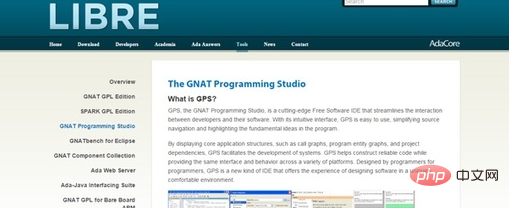 Operation and Maintenance
Operation and Maintenance
 Linux Operation and Maintenance
Linux Operation and Maintenance
 What are the C programming software on Linux?
What are the C programming software on Linux?
What are the C programming software on Linux?
C programming software on Linux includes: 1. eclipse, which can provide open source tools and environments for C and C programmers; 2. "Code::Blocks", which supports code compilation, debugging, code coverage, and analysis and automatic completion; 3. CodeLite, an open source cross-platform IDE; 4. NetBeans, etc.

#The operating environment of this tutorial: linux5.9.8 system, Dell G3 computer.
C/C is popular worldwide and indispensable in application and system development.
Decades have passed, C and C, as the main high-level programming languages, are still very popular around the world, and firmly occupy the top 5 of the TIOBE programming language rankings, applications and System development is inseparable from these two languages.
In this article, we will show you some programming software (IDE) for C/C that can be found on the Linux platform.
linux C programming software (IDE)
1) eclipse
Eclipse is the world’s most The most popular and powerful IDE. It provides open source tools and environments for C and C programmers. Beginners will find it very easy to get started using this IDE.

Features:
Freely available open source software.
Supports various platforms such as Windows, Linux, Mac OS X, etc.
Supports code debugging, compilation, analysis, automatic completion and reconstruction (code reorganization can be performed without changing the external operation).
Has a great Graphical User Interface (GUI) to arrange elements using drag and drop functionality.
Support static code analysis
2) Code::Blocks
Code::Blocks It is an open source, full-featured cross-platform C/C integrated development environment. This IDE contains all the features you need for C and C++ development.

Features:
Available for Windows, Linux and Mac OS X.
Fully customizable and scalable.
Supports code compilation, debugging, code coverage, analysis and automatic completion.
is a class browser. That is to say, it can visualize object-oriented programming.
Have features like Eclipse that allow you to use drag-and-drop functionality when arranging elements, and also support code analysis.
3) GNAT Programming Studio
GNAT Programming Studio, referred to as GPS, is a highly simplified interaction between software and developers. Advanced free IDE. GPS's natural interface makes it easy to use, simplifies the navigation of the source program, and also helps to highlight the basic ideas of the program.

Features:
Multi-platform support.
Supports code compilation, debugging, code coverage, analysis and automatic completion.
is also a class browser similar to Code:Blocks and also supports code refactoring.
Its drag and drop feature eases the programmer’s work
4) CodeLite
CodeLite It is a free, open source, cross-platform IDE created specifically for developers of C, C, PHP and JavaScript (mainly for node.js) programming languages. It can run on all major platforms (Windows, macOS and Linux)
Features:
Supports universal compilers and can click on errors through Buildtab.
Support next generation debugger.
Have an incredibly fast and powerful code completion tool based on an internal parser.
also has application-based RAD tools for building plug-ins.
Supports static code analysis, refactoring, class browser and program profiling.
5) NetBeans
Netbeans C IDE contains many projects based on C and C templates, providing C and C dynamic and static libraries to build applications. Its magical properties make it widely popular among web developers.
Features:
Free and open source IDE.
Multiple platform support.
Code completion is fast and supports C/C refactoring.
Well integrated multi-session gdb debugger.
It has functions such as automatic indentation, semantic highlighting, formatting (you can choose the formatting style), code folding, bracket matching and templates.
You can use development tools on the remote host to create, execute and even debug projects on the client system in a simple way.
6) Qt Creator
Qt Creator is another cross-platform IDE. Its design goal is to enable developers to use the Qt application framework to complete development tasks more quickly and easily.
Features:
Multi-platform support.
Supports code compilation, debugging, analysis, automatic completion and reconstruction.
Can be dragged and dropped freely.
Support static code analysis.
7) Anjuta
Anjuta is an all-round IDE that contains many advanced programming tools. It focuses on efficient development for developers. Provides a simple and usable interface. Although it is open source software, it only supports the Linux platform.
Features:
Anjuta UI is simple to operate and powerful.
Has simple wizards and templates for creating new projects.
Fully integrated with the debugging function of GDB.
project management.
Application Wizard.
Source code editor.
Analyzers and more.
8) MonoDevelop
MonoDevelop enables developers to write desktop and web applications on Linux, Windows and Mac OS X platforms. You can also write .NET applications created in Visual Studio on Linux and Mac OS X platforms using a code base that is the same and unique for all platforms.
Features:
Multi-platform support.
Advanced text editing
Multi-language support.
Integrated debugger.
Configurable workbench.
Web projects can be created entirely using code auto-completion.
9) CLion
CLion is a tool from Jetbrains that helps developers perform C and C on Linux, OS X and Windows platforms. A powerful IDE, CLion can effectively improve developer productivity through smart editors, code quality assurance tools, automatic refactoring tools, and tightly integrated CMake build systems.
Features:
Multi-platform support.
Supports various languages and standards.
Integrated version control system.
Embedded terminal system.
Smart editor.
Supports code compilation, debugging, analysis, automatic completion and reconstruction.
Supported by CMake system.
Related recommendations: "Linux Video Tutorial"
The above is the detailed content of What are the C programming software on Linux?. For more information, please follow other related articles on the PHP Chinese website!

Hot AI Tools

Undresser.AI Undress
AI-powered app for creating realistic nude photos

AI Clothes Remover
Online AI tool for removing clothes from photos.

Undress AI Tool
Undress images for free

Clothoff.io
AI clothes remover

AI Hentai Generator
Generate AI Hentai for free.

Hot Article

Hot Tools

Notepad++7.3.1
Easy-to-use and free code editor

SublimeText3 Chinese version
Chinese version, very easy to use

Zend Studio 13.0.1
Powerful PHP integrated development environment

Dreamweaver CS6
Visual web development tools

SublimeText3 Mac version
God-level code editing software (SublimeText3)

Hot Topics
 1378
1378
 52
52
 Difference between centos and ubuntu
Apr 14, 2025 pm 09:09 PM
Difference between centos and ubuntu
Apr 14, 2025 pm 09:09 PM
The key differences between CentOS and Ubuntu are: origin (CentOS originates from Red Hat, for enterprises; Ubuntu originates from Debian, for individuals), package management (CentOS uses yum, focusing on stability; Ubuntu uses apt, for high update frequency), support cycle (CentOS provides 10 years of support, Ubuntu provides 5 years of LTS support), community support (CentOS focuses on stability, Ubuntu provides a wide range of tutorials and documents), uses (CentOS is biased towards servers, Ubuntu is suitable for servers and desktops), other differences include installation simplicity (CentOS is thin)
 Centos stops maintenance 2024
Apr 14, 2025 pm 08:39 PM
Centos stops maintenance 2024
Apr 14, 2025 pm 08:39 PM
CentOS will be shut down in 2024 because its upstream distribution, RHEL 8, has been shut down. This shutdown will affect the CentOS 8 system, preventing it from continuing to receive updates. Users should plan for migration, and recommended options include CentOS Stream, AlmaLinux, and Rocky Linux to keep the system safe and stable.
 Detailed explanation of docker principle
Apr 14, 2025 pm 11:57 PM
Detailed explanation of docker principle
Apr 14, 2025 pm 11:57 PM
Docker uses Linux kernel features to provide an efficient and isolated application running environment. Its working principle is as follows: 1. The mirror is used as a read-only template, which contains everything you need to run the application; 2. The Union File System (UnionFS) stacks multiple file systems, only storing the differences, saving space and speeding up; 3. The daemon manages the mirrors and containers, and the client uses them for interaction; 4. Namespaces and cgroups implement container isolation and resource limitations; 5. Multiple network modes support container interconnection. Only by understanding these core concepts can you better utilize Docker.
 How to install centos
Apr 14, 2025 pm 09:03 PM
How to install centos
Apr 14, 2025 pm 09:03 PM
CentOS installation steps: Download the ISO image and burn bootable media; boot and select the installation source; select the language and keyboard layout; configure the network; partition the hard disk; set the system clock; create the root user; select the software package; start the installation; restart and boot from the hard disk after the installation is completed.
 How to use docker desktop
Apr 15, 2025 am 11:45 AM
How to use docker desktop
Apr 15, 2025 am 11:45 AM
How to use Docker Desktop? Docker Desktop is a tool for running Docker containers on local machines. The steps to use include: 1. Install Docker Desktop; 2. Start Docker Desktop; 3. Create Docker image (using Dockerfile); 4. Build Docker image (using docker build); 5. Run Docker container (using docker run).
 What are the backup methods for GitLab on CentOS
Apr 14, 2025 pm 05:33 PM
What are the backup methods for GitLab on CentOS
Apr 14, 2025 pm 05:33 PM
Backup and Recovery Policy of GitLab under CentOS System In order to ensure data security and recoverability, GitLab on CentOS provides a variety of backup methods. This article will introduce several common backup methods, configuration parameters and recovery processes in detail to help you establish a complete GitLab backup and recovery strategy. 1. Manual backup Use the gitlab-rakegitlab:backup:create command to execute manual backup. This command backs up key information such as GitLab repository, database, users, user groups, keys, and permissions. The default backup file is stored in the /var/opt/gitlab/backups directory. You can modify /etc/gitlab
 How to mount hard disk in centos
Apr 14, 2025 pm 08:15 PM
How to mount hard disk in centos
Apr 14, 2025 pm 08:15 PM
CentOS hard disk mount is divided into the following steps: determine the hard disk device name (/dev/sdX); create a mount point (it is recommended to use /mnt/newdisk); execute the mount command (mount /dev/sdX1 /mnt/newdisk); edit the /etc/fstab file to add a permanent mount configuration; use the umount command to uninstall the device to ensure that no process uses the device.
 What to do after centos stops maintenance
Apr 14, 2025 pm 08:48 PM
What to do after centos stops maintenance
Apr 14, 2025 pm 08:48 PM
After CentOS is stopped, users can take the following measures to deal with it: Select a compatible distribution: such as AlmaLinux, Rocky Linux, and CentOS Stream. Migrate to commercial distributions: such as Red Hat Enterprise Linux, Oracle Linux. Upgrade to CentOS 9 Stream: Rolling distribution, providing the latest technology. Select other Linux distributions: such as Ubuntu, Debian. Evaluate other options such as containers, virtual machines, or cloud platforms.





